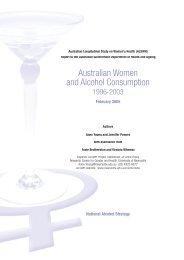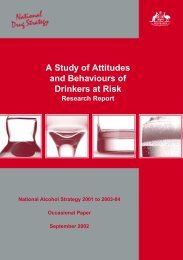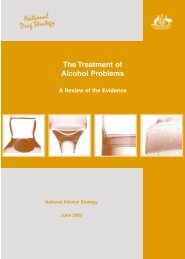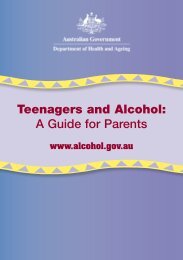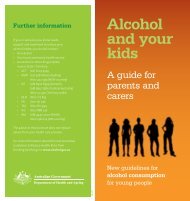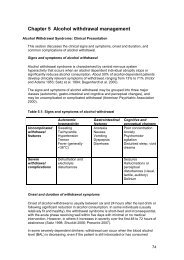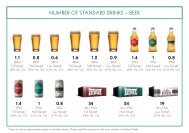Chapter 3 Screening, assessment and treatment planning - Alcohol
Chapter 3 Screening, assessment and treatment planning - Alcohol
Chapter 3 Screening, assessment and treatment planning - Alcohol
Create successful ePaper yourself
Turn your PDF publications into a flip-book with our unique Google optimized e-Paper software.
patients should be offered the least “restrictive” intervention appropriate to theirpresentation. Should the first intervention prove to be insufficient to achieve theagreed <strong>treatment</strong> goals for the patient, the next level of intensity of <strong>treatment</strong> shouldbe offered until the desired <strong>treatment</strong> goals are achieved. This approach requiresregular review <strong>and</strong> monitoring of the patient, their response to <strong>treatment</strong> <strong>and</strong> anychanges in their presentation (ie continuous <strong>assessment</strong>).Relapse prevention, aftercare <strong>and</strong> long-term follow-upRelapse is a common problem in alcohol <strong>treatment</strong>, with approximately 60% oftreated patients relapsing to problematic drinking within the first 12 months (Connorset al. 1996).It has long been observed that specific situations or mood states are associated withrelapse. Factors include: negative emotional states (e.g. frustration, anger, anxiety,depression or anger); interpersonal conflict (e.g. relationships with partner, workcolleagues, friends); <strong>and</strong> direct or indirect social pressure to drink (Marlatt <strong>and</strong>George 1984).Relapse prevention addresses itself to the maintenance of change, <strong>and</strong> to thedevelopment of self-efficacy <strong>and</strong> coping skills (Edwards et al. 2003). Relapseprevention can be assisted through the use of medication, including alcoholpharmacotherapies for reducing alcohol use (e.g. naltrexone, acamprosate,disulfiram), or medication directed towards addressing psychological problems suchas anxiety or depression (See <strong>Chapter</strong> 6).Aftercare or extended care refers to the period immediately following intensive<strong>treatment</strong> (See <strong>Chapter</strong> 11). Aftercare acknowledges the fact that severe alcoholproblems are prone to recurrence <strong>and</strong> that maintenance of change may require someongoing monitoring <strong>and</strong> assistance beyond the active phase of initial <strong>treatment</strong>. It isparticularly suited to people with severe dependence whose likelihood of relapse isgreater. It consists of planned telephone or face-to-face contact following a period of<strong>treatment</strong> to discuss progress <strong>and</strong> any problems that may have arisen since the endof active <strong>treatment</strong>.Structured aftercare is more effective than patient-initiated, unstructured aftercare(See <strong>Chapter</strong> 11).Many clinicians may use referral to self-help programs (such as <strong>Alcohol</strong>icAnonymous <strong>and</strong> SMART Recovery) as forms of continuing care, although aftercaregenerally refers to contact with the treating clinician or service with the goal ofmaintaining <strong>treatment</strong> gains. Often primary care workers (e.g. general practitioners)can provide this function through ongoing follow-up of other health issues (See<strong>Chapter</strong> 8).Recommendation3.23 Treatment plans should be modifiedaccording to re<strong>assessment</strong> <strong>and</strong> response tointerventions (stepped care approach).3.24 Evidence-based <strong>treatment</strong> should beoffered in a clinical setting with the appropriateresources based on the patient’s needs.Strength ofrecommendationSSLevel ofevidence40



